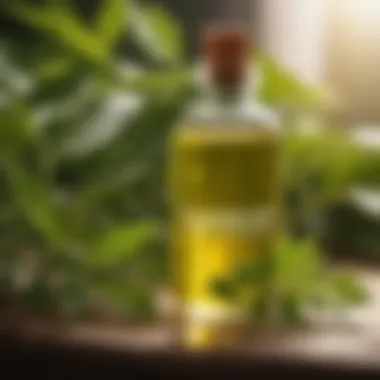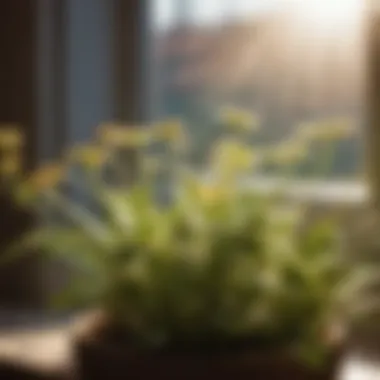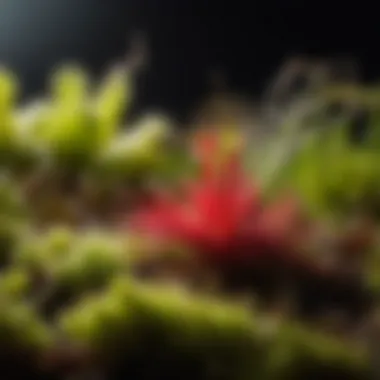Effective Strategies for Dealing with Gnats on Indoor Plants - A Comprehensive Guide


Materials:
- Hydrogen peroxide
- Sticky traps
- Potting gravel
- Neem oil
- Petroleum jelly
DIY Steps:
- Identify the Infestation: Carefully inspect the soil and foliage of your plants to confirm the presence of gnats.
- Create a Gnat Trap: Mix hydrogen peroxide with water in a 1:4 ratio and pour it into jars with small openings. Gnats will be attracted to the mixture and drown.
- Utilize Sticky Traps: Place sticky traps near your plants to catch adult gnats flying around.
- Use Potting Gravel: Cover the soil surface with potting gravel to deter gnats from laying eggs.
- Apply Neem Oil: Dilute neem oil with water and spray it on the plant foliage to kill larvae and deter adult gnats.
- Apply Petroleum Jelly: Create a barrier of petroleum jelly around the rims of plant pots to prevent gnats from laying eggs in the soil.
Technical Aspects:
- Tools: Spray bottle, jars, watering can
- Timing: Perform these actions consistently over a few weeks to ensure complete eradication of gnats.
- Critical Techniques: Correctly mix the solutions, place the traps strategically, and apply treatments evenly across affected plants.
DIY Project Process:
- 1. Identify the Infestation: Look for signs of gnats and confirm their presence.
- 2. Create Trap Solutions: Mix hydrogen peroxide, water, neem oil solutions carefully.
- 3. Implement Traps: Place traps near plants and watering sources.
- 4. Apply Treatments: Spray neem oil on foliage and apply petroleum jelly to pot rims.
Troubleshooting Tips:
- If traps are not effective, increase the number placed around the plants.
- Ensure consistency in applying treatments to prevent gnat resurgence.
- Review watering practices to avoid creating ideal gnat breeding conditions.
Understanding Gnats
Gnats, small flying insects that can infest indoor plants, pose a significant threat to plant health and aesthetics. In this article, delving deep into the topic of Understanding Gnats is crucial to equip plant enthusiasts with the knowledge needed to combat these pests effectively. By understanding the lifecycle, behavior patterns, and identifying key characteristics of gnats, individuals can implement targeted strategies to eliminate and prevent infestations. This section serves as the foundation for the subsequent discussions on preventive measures, natural remedies, chemical treatments, advanced control methods, and integrated pest management techniques.
Identification of Gnats
Physical Characteristics
When discussing the Physical Characteristics of gnats, it is imperative to highlight their tiny size, delicate appearance, and muted coloration. These features enable gnats to easily go unnoticed in indoor environments, making them a challenging pest to detect. The seemingly harmless nature of their appearance juxtaposes the significant damage they can inflict on indoor plants. Understanding these Physical Characteristics is critical for early detection and swift intervention in gnat infestations.
Behavior Patterns
Gnats exhibit peculiar Behavior Patterns that contribute to their survival and proliferation on indoor plants. Their attraction to moist environments, such as overly watered potted plants, stems from their breeding preferences in damp conditions. Additionally, gnats' tendency to hover around the soil surface in search of organic matter highlights their role as decomposers. By illuminating these Behavior Patterns, plant owners can pinpoint areas of vulnerability in their plant care routines and tailor preventive measures accordingly.
Impact of Gnats on Plants
Damage Caused


The Damage Caused by gnats encompasses a range of detrimental effects on indoor plants, including root damage, decreased nutrient uptake, and compromised plant growth. Gnats lay their eggs in the soil, leading to larval feeding on plant roots, resulting in weakened plant health. This damage not only affects the current growth of the plant but also hampers its future development. Recognizing the extent of Damage Caused by gnats is essential for implementing targeted interventions to mitigate their impact.
Signs of Infestation
Identifying the Signs of Infestation early is paramount in effectively managing gnat populations on indoor plants. Common signs include the presence of adult gnats flying around plants, tiny larvae in the soil, and wilting or yellowing leaves due to root damage. By recognizing these telltale signs, plant owners can take prompt action to prevent further infestation and protect the overall well-being of their plants.
Preventive Measures
Preventive measures are a crucial component of maintaining healthy indoor plants. In the context of dealing with gnats, implementing preventive measures can significantly reduce the risk of infestations and ensure the well-being of your plants. By focusing on proactive strategies, such as proper plant care practices and optimizing growing conditions, you can create an environment that is less conducive to gnat proliferation. These preventative steps not only protect your current plants but also help to prevent future infestations, saving you time and resources in the long run.
Proper Plant Care Practices
Appropriate Watering Techniques
Appropriate watering techniques play a fundamental role in preventing gnat infestations and promoting plant health. Overwatering is a common issue that can attract gnats due to the excess moisture in the soil, creating an ideal breeding ground. By adopting a mindful watering schedule that allows the soil to dry out slightly between waterings, you can discourage gnats from laying eggs and thriving in damp conditions. This method helps maintain the right balance of moisture for your plants while minimizing the risk of gnat infestations.
Regular Pruning
Regular pruning is another essential practice in plant care that contributes to gnat prevention. Removing dead or decaying plant matter not only enhances the aesthetic appeal of your indoor garden but also eliminates potential breeding sites for gnats. By keeping your plants well-trimmed and free from debris, you create an environment that is less welcoming to gnats, reducing the likelihood of infestations. Additionally, pruning promotes healthy growth and allows for better air circulation, further deterring gnat populations from flourishing in your indoor space.
Optimizing Growing Conditions
Temperature and Humidity Control
Maintaining optimal temperature and humidity levels is key to creating an inhospitable environment for gnats. Gnats thrive in warm, humid conditions, making temperature and humidity control crucial in gnat prevention. By regulating the environmental factors in your indoor space, such as using a dehumidifier or adjusting the thermostat, you can discourage gnat activity and minimize infestation risks. Controlling these variables not only benefits your plants but also disrupts the gnat lifecycle, preventing their population from growing unchecked.
Choosing Well-Draining Soil
Selecting well-draining soil is essential for gnat prevention, as it helps prevent water stagnation and root rot – conditions that attract gnats. Well-draining soil allows excess moisture to escape easily, reducing the risk of waterlogged conditions that are favorable to gnat larvae. By choosing soil that promotes good drainage, you create an environment that is less favorable to gnats, helping to safeguard your plants from infestations. Additionally, well-draining soil supports healthy root development and overall plant vitality, maximizing the success of your indoor garden.
Natural Remedies
Natural remedies play a vital role in effectively combating gnat infestations on indoor plants. In this article, we explore the significance of incorporating natural solutions to address this issue. Natural remedies offer a safer alternative to chemical treatments, ensuring plant health while minimizing environmental impact. The focus on natural remedies aligns with a growing trend towards eco-friendly and sustainable gardening practices, making it an essential consideration for plant enthusiasts seeking holistic solutions for pest control.
Neem Oil Solution
Preparation and Application
The preparation and application of neem oil are integral to the overall success of using this natural remedy. Neem oil is renowned for its potent insecticidal properties, making it a preferred choice for combating gnats on indoor plants. Its unique feature lies in its ability to disrupt the lifecycle of gnats, targeting both adult insects and their larvae effectively. While neem oil is generally safe for plants, it is advisable to follow specific guidelines on dilution ratios and application frequency to ensure optimal results without causing harm to plant growth. The ease of preparation and application makes neem oil a popular choice for plant owners looking for an efficient and environmentally friendly solution.


Benefits and Effectiveness
The benefits of using neem oil extend beyond its insecticidal properties. Apart from eradicating gnats, neem oil also functions as a natural fungicide, safeguarding plants against fungal infections. Additionally, neem oil has reported anti-bacterial properties, further promoting overall plant health. Its effectiveness in controlling a wide range of pests while being biodegradable makes it a preferred option for sustainable pest management in indoor gardening. However, it is essential to note that neem oil may have a strong odor that dissipates over time and can cause leaf burn if applied in direct sunlight. Understanding these nuances can maximize the benefits of neem oil application in combating gnats effectively.
Diatomaceous Earth
Usage Instructions
Diatomaceous earth, another natural remedy for gnat infestations on indoor plants, offers a mechanical approach to pest control. Its usage instructions involve applying a thin layer of diatomaceous earth on the soil surface of plants susceptible to gnat infestations. The key characteristic of diatomaceous earth is its abrasive nature, which damages the exoskeleton of gnats upon contact, leading to their eventual elimination. This method is popular among plant owners due to its non-toxic nature and long-lasting efficacy in deterring various pests, including gnats. However, caution should be exercised to prevent inhalation of diatomaceous earth particles, especially for individuals with respiratory sensitivities.
Mechanism of Action
The mechanism of action of diatomaceous earth centers around its physical properties. When gnats come into contact with diatomaceous earth, the abrasive particles pierce their exoskeleton, causing dehydration and eventual death. This natural desiccant effect makes diatomaceous earth an effective deterrent against gnats without the use of harmful chemicals. However, it is essential to reapply diatomaceous earth regularly, especially after watering, to maintain its effectiveness in controlling gnat populations. Understanding the mechanism of action empowers plant owners to make informed decisions on integrating diatomaceous earth into their pest management strategies.
Chemical Treatments
Insecticidal Soaps
Application Guidelines
Application guidelines in the realm of insecticidal soaps are crucial for achieving optimal results in controlling gnat populations on indoor plants. These guidelines outline the correct method and frequency of applying insecticidal soaps to ensure maximum efficacy while minimizing the risk to plant health. The key characteristic of application guidelines lies in their precise instructions, which help users administer the soap in a way that effectively targets gnats while safeguarding plant foliage. This precision makes application guidelines a popular choice for gnat control in this article, as their step-by-step approach simplifies the process for plant owners. Despite their advantages, it's important to note that misapplication could potentially harm plants, highlighting the need for strict adherence to prescribed guidelines.
Safety Precautions
Safety precautions associated with insecticidal soaps are paramount in ensuring the well-being of both plants and individuals handling these substances. Emphasizing safety protocols when using insecticidal soaps mitigates risks of plant damage or personal harm, reinforcing their reputation as a safe and effective option for gnat control in this article. The unique feature of safety precautions lies in their ability to protect plants while promoting user safety, making them a reliable choice for indoor plant enthusiasts. However, it's crucial to consider that prolonged exposure or misuse of insecticidal soaps could lead to unintended consequences, underscoring the need for cautious and informed application.
Pyrethrin-Based Sprays
Efficacy and Risks
Pyrethrin-based sprays stand out for their dual nature of efficacy and associated risks in combating gnat infestations on indoor plants. The efficacy of these sprays lies in their potent formula, which swiftly targets and eliminates gnats upon contact, offering a quick solution to persistent infestations. However, the risks associated with pyrethrin-based sprays include potential harm to beneficial insects and pets if not used judiciously. This balance of efficacy and risks positions pyrethrin-based sprays as a beneficial yet nuanced choice for gnat control in this article, where the focus is on effective outcomes while minimizing collateral damage.
Correct Application
The correct application of pyrethrin-based sprays is critical to harnessing their full potential in addressing gnat issues effectively on indoor plants. Highlighting the proper method of application ensures that the spray targets gnats efficiently without compromising plant health or environmental safety. The key characteristic of correct application lies in its precision and attention to detail, guaranteeing that the spray is applied evenly and adequately to tackle gnat populations. This approach makes correct application a popular choice for gnat control in this article, as it underscores the importance of following instructions to achieve successful outcomes. Despite its advantages, deviations from correct application procedures could lead to suboptimal results or unintended consequences, underscoring the significance of adherence to recommended practices.
Advanced Control Methods


In the realm of dealing with gnats on indoor plants, advanced control methods play a pivotal role in ensuring the effective management of these pesky pests. These methods offer a higher level of precision and control, making them essential in combating gnat infestations. By incorporating advanced techniques, individuals can elevate their pest control strategies to a more targeted approach, thereby increasing the likelihood of successful eradication. These methods bring forth a range of benefits, such as enhanced efficiency in gnat removal, decreased likelihood of reinfestation, and a more environmentally friendly approach compared to harsh chemicals. Additionally, advanced control methods signify a proactive stance towards plant care, showing a commitment to maintaining a healthy indoor plant environment.
Sticky Traps
Placement and Monitoring
When it comes to utilizing sticky traps as part of gnat control, the strategic placement and diligent monitoring of these traps are key components for successful pest management. Proper placement involves positioning the traps near plants where gnats are prevalent, ensuring maximum capture potential. By monitoring the traps regularly, individuals can gauge the effectiveness of their placement and adjust as needed to target gnat hotspots. The adhesive surface of sticky traps acts as a powerful attractant for gnats, trapping them upon contact. This method is widely favored for its non-intrusive nature and ability to capture a significant number of gnats without the need for chemicals. However, one drawback of sticky traps can be their aesthetic impact in indoor spaces, which may be a consideration for some users looking for more discreet pest control solutions.
Effectiveness Assessment
Assessing the effectiveness of sticky traps is crucial in evaluating the impact of these control methods on gnat populations. By tracking the number of gnats captured over time, individuals can measure the success of sticky traps in reducing infestations. The key characteristic of effectiveness assessment lies in its quantitative approach, providing tangible data on the efficacy of the traps. This data-driven method allows plant owners to make informed decisions on the continued use or modification of sticky traps in their pest control regimen. While sticky traps excel at capturing adult gnats, they may not address gnat larvae or eggs present in the soil, necessitating a comprehensive pest management approach that considers all life stages of the pests.
Integrated Pest Management
Gnats infesting indoor plants can be a challenging issue for plant enthusiasts. Integrated Pest Management (IPM) emerges as a comprehensive approach to effectively manage these pesky insects while minimizing environmental impact. This holistic strategy combines various methods to control gnat populations sustainably. By integrating natural remedies, chemical treatments, and advanced control methods, IPM ensures a balanced and efficient approach to combating gnats.
Implementing IPM benefits indoor plant caretakers by offering a well-rounded solution that addresses infestations from multiple angles. This approach emphasizes the harmony between plant health and environmental preservation, advocating for long-term pest control strategies. Through meticulous planning and systematic execution, IPM fosters a symbiotic relationship between plants and beneficial insects, promoting a self-sustaining ecosystem within indoor gardens.
Rotation of Control Methods
Combining Strategies
In the context of gnat management, Combining Strategies is a pivotal element of IPM that involves integrating various control methods to achieve optimal results. By blending natural remedies, chemical treatments, and advanced control mechanisms, Combining Strategies harnesses the strengths of each approach to create a synergistic effect that effectively tackles gnat infestations.
The key characteristic of Combining Strategies lies in its versatility and adaptability to diverse infestation scenarios. This approach ensures a tailored response to gnat problems, optimizing effectiveness while reducing the risk of resistance development in gnat populations. The unique feature of Combining Strategies is its ability to create a comprehensive defense system that targets gnats at different life stages, offering a multi-faceted solution that minimizes the chances of recurring infestations.
Consistency in Implementation
Consistency in Implementation plays a crucial role in sustaining the effectiveness of pest control measures over time. By adhering to a consistent approach in gnat management, plant caretakers ensure stable and predictable results in combatting infestations. This aspect of IPM emphasizes the importance of regular monitoring and application of control methods to maintain control over gnat populations reliably.
The key characteristic of Consistency in Implementation is its ability to establish a routine that fosters proactive pest management. By consistently implementing control measures, plant owners create a conducive environment for plant growth while minimizing gnat-related disruptions. The unique feature of Consistency in Implementation is its long-term efficacy in preventing gnat resurgence, making it a valuable tool in sustaining a gnat-free indoor garden environment.
Monitoring and Evaluation
Tracking Progress
Tracking Progress is an essential component of effective gnat management within an IPM framework. By monitoring the outcomes of control measures, plant caretakers can gauge the success of their strategies and make informed decisions on further interventions. This aspect of IPM enables continuous assessment of gnat populations and the efficacy of implemented control methods, allowing for timely adjustments to optimize pest management efforts.
The key characteristic of Tracking Progress is its ability to provide real-time feedback on the effectiveness of gnat control strategies. By tracking changes in gnat populations and plant health indicators, indoor gardeners can identify trends and patterns that inform future pest control approaches. The unique feature of Tracking Progress is its role in facilitating data-driven decision-making, empowering plant owners to tailor their strategies for maximum impact.
Adjusting Approaches
Adjusting Approaches complements Tracking Progress by offering a dynamic response to evolving gnat infestation challenges. This aspect of IPM encourages plant caretakers to adapt their control methods based on monitoring results, environmental conditions, and gnat behavior patterns. By remaining flexible and responsive to changing circumstances, indoor gardeners can refine their approaches for sustained gnat management success.
The key characteristic of Adjusting Approaches is its agility and responsiveness in addressing gnat infestations proactively. By fine-tuning control methods in response to emerging challenges, plant owners stay ahead of gnat populations' dynamics, minimizing damage to plants and maximizing control efficacy. The unique feature of Adjusting Approaches is its ability to foster a resilient pest management strategy that evolves in tandem with gnat populations, ensuring long-term success in maintaining a healthy indoor plant environment.







